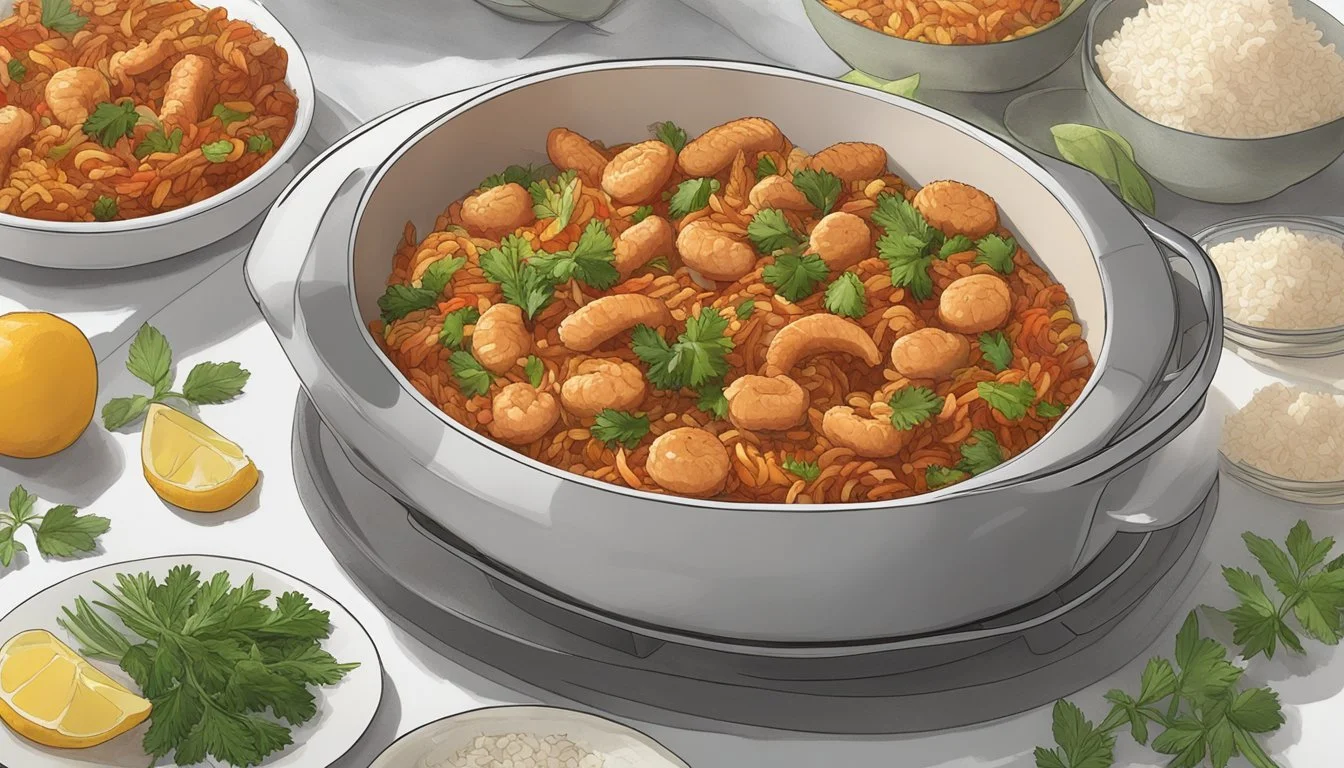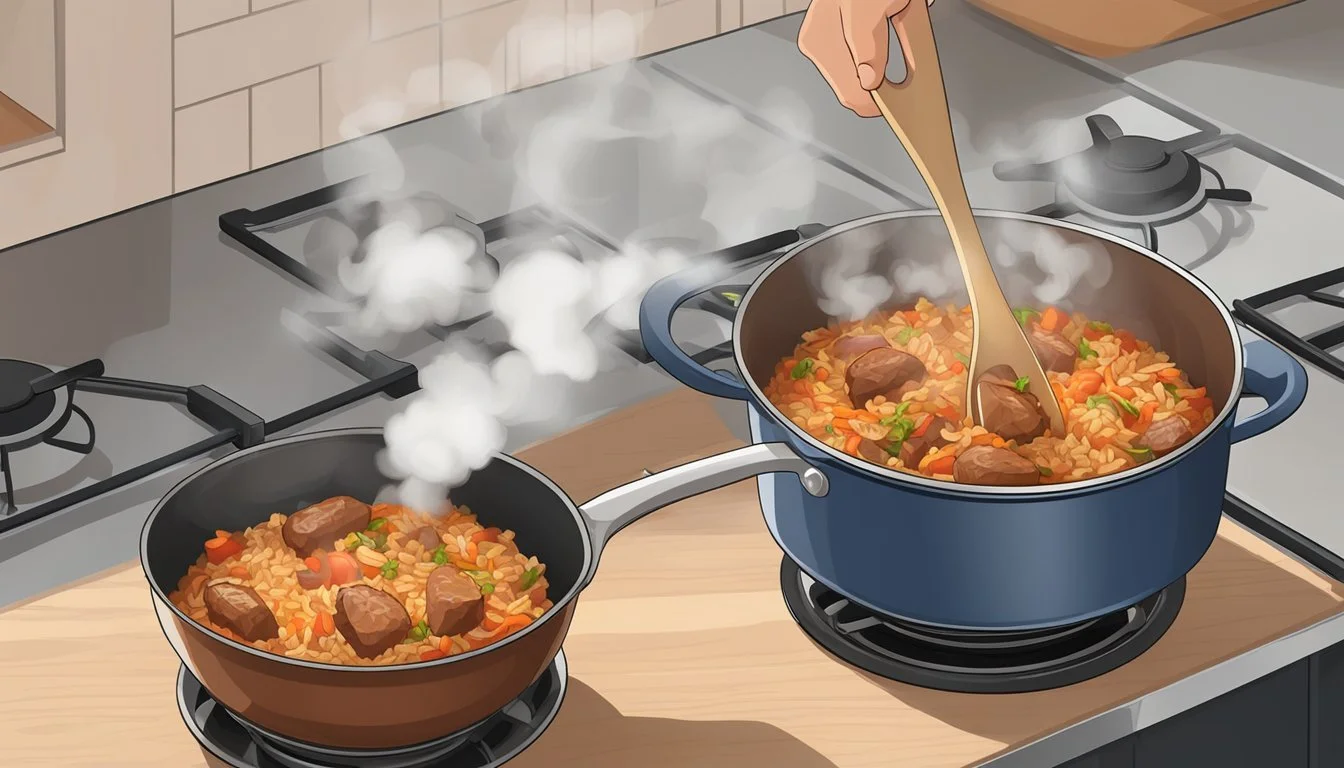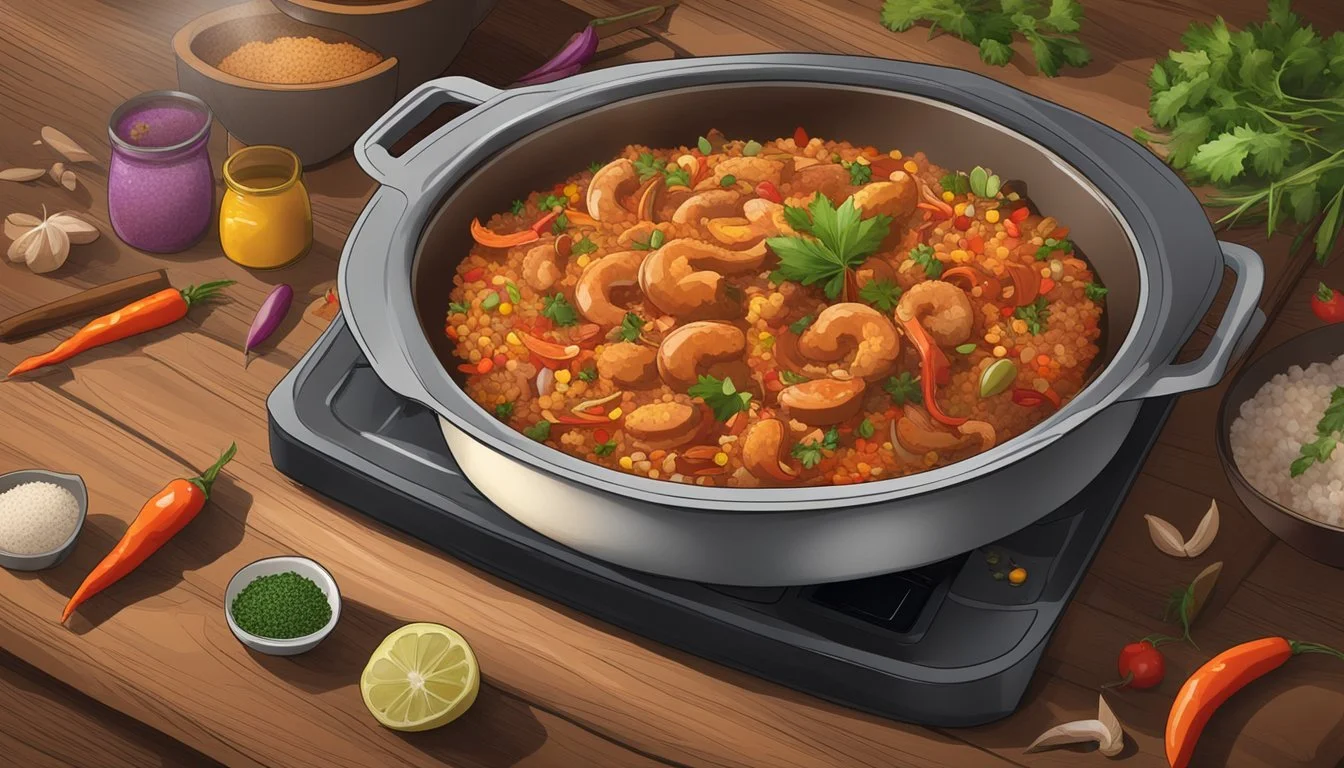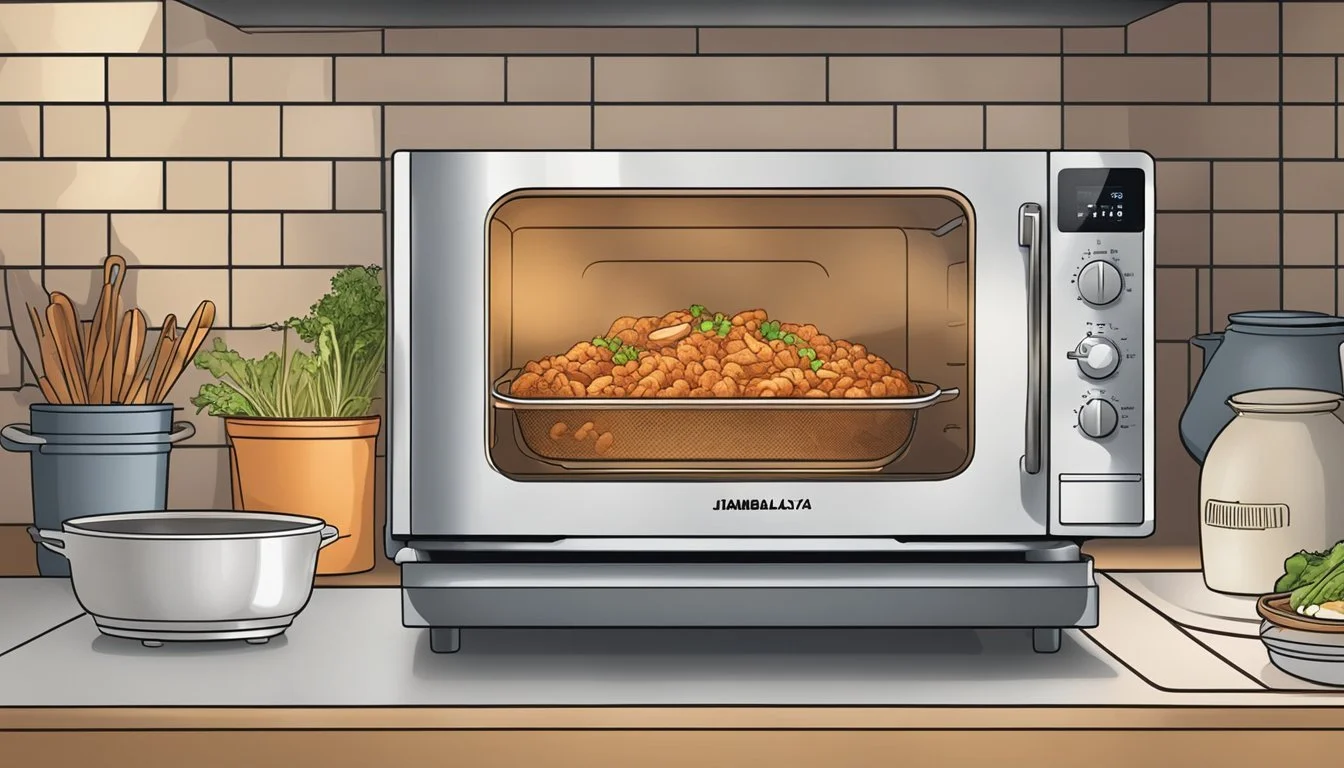Best Way to Reheat Jambalaya
Tips for Perfectly Fluffy Rice Every Time
Jambalaya, a hearty Creole dish loaded with flavor, spices, and a mix of chicken, sausage, and often shrimp, is as delightful to savor the second time around as it is fresh from the pot. However, reheating this Louisiana staple without compromising its texture—particularly that of the rice, which has a proclivity for clumping and drying out—presents a culinary challenge to both seasoned cooks and novices alike. A successful warming requires a careful approach to restore the dish's savory moisture and separate each grain of rice.
With several techniques at disposal, choosing the right one for reheating jambalaya is vital to maintaining its original charm. The key is to apply gentle heat and introduce a small amount of additional moisture while avoiding excessive stirring, which can turn rice mushy or clumpy. Utilizing the correct method not only revives the dish to its former glory but also ensures that the interplay of flavors and textures within the jambalaya remains as intended, providing a satisfying leftovers experience.
It's important to remember that safety is as important as taste, so jambalaya should be stored properly before reheating to prevent any potential food-borne illness. Leftovers should be cooled quickly and refrigerated within two hours of cooking, ensuring jambalaya maintains its quality and becomes a safe and enjoyable encore meal. Whether utilizing an oven, stovetop, or microwave, reheating jambalaya can be done efficiently with the right technique, safeguarding the vibrancy of this beloved Southern dish.
Understanding Jambalaya
Before diving into the complexities of reheating jambalaya, it's essential to grasp the dish's nature and its place in culinary tradition. Jambalaya prides itself as a one-pot rice dish teeming with a rich blend of flavors and cultural history.
Components of Jambalaya
Jambalaya typically consists of three fundamental parts: protein, vegetables, and rice. Proteins such as chicken, sausage, or seafood are common, while the vegetables usually include a trinity of onions, celery, and bell peppers. Rice, the staple component, absorbs the flavors of the broth and spices, giving the dish its signature texture and taste. Spices, often featuring Cajun seasoning, bring heat and depth to jambalaya, distinguishing it from other rice dishes.
Jambalaya as a Louisiana Dish
Originating from Louisiana, jambalaya is a testament to the state's diverse heritage, combining elements of Cajun and Creole cuisine. The Cajun variation, often more rustic, typically lacks tomatoes and relies on a smoked pork sausage like andouille, while the Creole or "red" jambalaya includes tomatoes, creating a vibrant, tangy flavor profile.
Similar Rice Dishes
Globally, several rice dishes bear resemblance to jambalaya in their make-up as hearty, spiced, one-pot meals. Spain's paella is perhaps the most akin; however, it frequently features saffron and is generally less spicy. Both dishes underline the cultural significance and versatility of rice in culinary traditions worldwide.
Storing Leftover Jambalaya
Proper storage is essential to maintaining the quality and safety of leftover jambalaya. The following subsections detail the best practices for refrigerating and freezing jambalaya, preventing bacterial growth, and identifying when it is time to discard leftovers.
Refrigerator Storage
Leftover jambalaya should be stored in the refrigerator within two hours of cooking to prevent the growth of bacteria. It should be placed in a sealed container and can be refrigerated for 3-4 days. If the jambalaya contains seafood, one should limit storage to 2 days.
Freeze Jambalaya Properly
For extended storage, leftover jambalaya can be frozen. To do this:
Allow the jambalaya to cool completely.
Divide into serving-sized portions for easier thawing.
Place the portions in airtight containers or freezer bags, leaving some space to allow for expansion.
Label the containers with the date and freeze. Jambalaya can remain frozen for up to 3 months for the best quality.
Preventing Bacteria Growth
One important consideration when storing leftovers is the prevention of Bacillus cereus, a bacteria commonly found in rice. To minimize risk:
Do not leave jambalaya at room temperature for longer than necessary.
Ensure the refrigerator temperature is set below 40°F (4°C).
Cool down the jambalaya quickly by spreading it on a shallow dish if possible before refrigerating.
Recognizing Spoilage
Spotting spoiled jambalaya is critical for food safety. Indicators include:
An off or sour smell.
Visible mold or discoloration.
Any slimy texture on the rice or other components. When any signs of spoilage are observed, the jambalaya should be discarded to avoid the risk of foodborne illness.
Reheating Jambalaya: Overview
Proper reheating techniques ensure that leftover jambalaya is both safe to eat and still delicious. This section provides an overview of the principles one should keep in mind while reheating and the methods available.
General Reheating Principles
When reheating jambalaya, the main goal is to maintain its texture and flavor while ensuring it is heated to a safe internal temperature. Jambalaya should be reheated to at least 165°F as recommended by food safety guidelines to prevent foodborne illness. It's also crucial to add a small amount of liquid to prevent the rice from drying out or clumping. The best liquids to use are broth or water which can help preserve moisture and enhance taste. An even distribution of heat is essential to avoid certain spots being too hot or too cold. Thorough stirring also plays a crucial role in preventing hotspots and ensuring even reheating throughout the dish.
Selecting the Right Reheating Method
The method chosen for reheating jambalaya can affect the dish's quality. Here are the most common reheating practices:
Oven: Encasing the jambalaya in an oven-safe dish covered with foil locks in moisture and heats it evenly. Preheat the oven to 350°F before cooking.
Stovetop: Using a frying pan over medium heat, stirring frequently, helps distribute heat evenly. Be sure to add liquid and cover if possible.
Microwave: Short bursts on medium power, stirring in between, helps to warm it without overcooking. Cover the dish to contain moisture.
Each method has its pros and cons. Oven reheating provides an even, gentle heat but can take longer. The stovetop is faster but requires attention to avoid burning. The microwave is the quickest but can lead to unevenly heated food if not done carefully.
Reheating Jambalaya on the Stove
Reheating jambalaya on a stove offers control over the heat and can help maintain the dish's texture. Below is a detailed guide to effectively rewarm jambalaya on the stovetop, keeping the rice from clumping and preserving the original flavor.
Step-By-Step Guide
Select a pan: Use a heavy-bottomed pan to distribute heat evenly.
Heat the pan: Begin by setting the stove to medium heat.
Add jambalaya: Place the jambalaya evenly in the pan, spreading it out.
Stir regularly: Stir the mixture every few minutes to ensure even heating and to prevent sticking.
Adding Liquids to Prevent Drying
Measure the liquid: Add a tablespoon of water or broth for each cup of jambalaya.
Mix it in: Gently fold the liquid into the jambalaya to distribute it without breaking up the rice grains.
Warm it up: Heat the jambalaya until it's hot throughout, which should take about 5 minutes. Do not overcook to avoid mushy rice.
Reheating Jambalaya in the Oven
Reheating jambalaya in the oven is an effective method to ensure the rice does not clump and the dish retains its moisture. Careful temperature control and proper covering are essential to achieve the best results.
Preheat the Oven
Before reheating the jambalaya, preheat the oven to 350°F (180°C). This ensures that the oven environment is uniformly heated and ready to warm the jambalaya without overcooking it.
Cover with Aluminum Foil
To prevent the jambalaya from losing moisture and to promote even heating, place the jambalaya in an oven-safe dish. Then, one should add a small amount of stock or water—about 2-3 tablespoons—to the dish. Cover the dish with aluminum foil to seal in the moisture, which is crucial for keeping the rice from drying out and clumping.
Oven Reheating Duration
The duration for reheating jambalaya in the oven usually depends on the portion size. For a typical serving, heat the dish in the preheated oven for about 20-30 minutes. The goal is to heat the jambalaya thoroughly without allowing the rice to become mushy. It is recommended to check the temperature of the jambalaya to ensure it has reached 165°F (74°C), the safe temperature for leftover dishes.
Reheating Jambalaya in the Microwave
When reheating jambalaya in the microwave, it is essential to maintain the texture of the rice and evenly distribute the heat. Using microwave-safe dishes, stirring thoroughly, and adjusting microwave settings maximizes the dish's quality.
Using Microwave-Safe Dishes
The choice of container can greatly affect the reheating process.
Material: Always opt for a dish made from microwave-safe materials to avoid any health hazards or damage to the dish.
Size: The dish should be large enough to spread out the jambalaya, ensuring even reheating.
Stirring to Even Out Heat
Microwaves can reheat food unevenly, so it is necessary to stir the jambalaya for consistent temperature throughout.
After the initial heating, pause and stir the jambalaya before continuing to microwave.
Ensure that the center of the dish gets mixed to the outside edges, and vice versa.
Adjusting Microwave Settings
The right settings can prevent overcooking the rice or causing it to clump.
Start with a high power setting for the initial minute of reheating, then reduce to a medium setting if needed.
Monitor: Keep an eye on the rice as it heats to determine if additional time or adjustments are necessary.
Ensuring Food Safety While Reheating
When reheating jambalaya, it's crucial to bring the dish to a temperature that's high enough to kill potentially harmful bacteria and ensure food safety. The two main focuses are on reaching safe internal temperatures and properly using a food thermometer to check these temperatures.
Reheating to Safe Temperatures
Jambalaya, like any other perishable food, must be reheated to a minimum internal temperature of 165°F to prevent the risk of foodborne illnesses. Bacteria that can cause food poisoning grow rapidly at temperatures between 40°F and 140°F, the range known as the "danger zone." When reheating, it's essential to minimize the time jambalaya spends in this zone.
Use of a Food Thermometer
Using a food thermometer is the only way to confirm that jambalaya has reached a safe temperature. It should be inserted into the thickest part of the dish, avoiding the bottom of the container to get an accurate reading. Follow these guidelines:
Preheat the oven or stove before reheating to ensure a consistent cooking temperature.
Stir the jambalaya periodically while heating to distribute heat evenly.
Verify that the entire dish has reached 165°F before consumption.
Serve immediately after reheating to prevent the temperature from dropping back into the danger zone.
By maintaining the recommended temperatures and using a food thermometer, individuals can drastically reduce the risk of bacteria growth and food poisoning. It's imperative to adhere to food safety guidelines to enjoy jambalaya that's not only delicious but also safe to eat.
Adding Freshness to Reheated Jambalaya
Reheating jambalaya can lead to a loss of the vibrant flavors that are characteristic of this dish. However, integrating fresh ingredients and utilizing thoughtful serving suggestions can significantly rejuvenate its appeal.
Incorporating Fresh Ingredients
Herbs: Adding freshly chopped herbs such as parsley, green onions, or cilantro to your reheated jambalaya can dramatically enhance its flavor profile. A sprinkle of these herbs not only brings a burst of color but also infuses the dish with freshness.
Garnishes: Consider lemon wedges or diced ripe tomatoes as garnish to add a fresh element to each serving. The acidity from the lemon can help to cut through the richness of the jambalaya, providing a more balanced flavor.
Serving Suggestions
Salad: Pairing a side salad with jambalaya introduces a crisp, refreshing contrast. A simple salad dressed with a vinaigrette complements the heavier, spicier notes of the jambalaya.
Bread: Serving warm, crusty bread on the side not only adds texture but also provides a vehicle for sopping up any flavorful sauce that might remain on the plate. Choosing a bread like a baguette can add an element of crunch and absorbency to the meal.
Addressing Common Reheating Problems
In the pursuit of reviving leftover jambalaya, the typical hurdles one faces involve clumping rice and dried out meat. Below are strategies to circumvent these issues and restore the dish to its near-original state.
Keeping Rice from Clumping
To prevent rice from becoming sticky and clumpy during reheating, one must reintroduce moisture. Here's how:
Stirring: Gently stir the rice several times while reheating to redistribute heat and moisture.
Moisture Addition: Add a small amount of broth or water before reheating:
Oven: 2-3 tablespoons per cup of jambalaya.
Stovetop: 1 tablespoon per cup of jambalaya.
Consistent heat and moisture will ensure the rice retains its distinct grains without becoming mushy.
Dealing with Dried Out Meat
Meat such as chicken, sausage, and shrimp can easily dry out when reheated improperly. To retain the juiciness:
Low Heat: Use a low heat setting to gradually warm the meat without extracting its moisture.
Covering: In the oven, tightly seal the dish with foil; on the stove, use a fitting lid.
Timing: Monitor closely—the goal is to heat through, not cook further.
By applying these techniques, the meat will maintain its flavor and texture, typically allowing for reheating without becoming dried out or tough.
Enhancing the Reheating Experience
To elevate the enjoyment of reheated jambalaya, one must consider pairing with the right beverages and sides. These accompaniments should complement the flavor and texture of the jambalaya, ensuring that the consistency of the dish remains appealing and that it retains its status as comforting southern cuisine
Pairing with Beverages
Jambalaya's rich flavors and heartiness pair well with a variety of beverages that can enhance the meal's overall experience. A well-chosen drink not only quenches thirst but also balances the dish’s spicy profile.
Non-Alcoholic Options:
Sweet iced tea, a southern staple, provides a refreshing counter to jambalaya's spice.
Lemonade, with its tartness, can cleanse the palate and complement seafood variations.
Alcoholic Options:
A light lager or pilsner beer can cut through the dish's heaviness.
For wine enthusiasts, a crisp Sauvignon Blanc or a Chardonnay pairs well by echoing the dish's richness without overwhelming it.
Complementing with Sides
Choosing the right sides can enhance the reheated jambalaya by adding differing textures and flavors that make the dish more enjoyable.
Bread:
A piece of crusty bread, such as a baguette, is perfect for soaking up any sauce and maintaining the balance between soft and firm textures.
Cornbread can add a sweet note and a crumbly texture that contrasts with the creamy consistency of well-reheated jambalaya.
Salads and Garnishes:
A simple green salad with a zesty dressing can offer a crisp texture and a fresh taste to cleanse the palate.
Garnishes like chopped green onions or parsley can add a splash of color and a slight crunch to the dish.
Alternate Reheating Methods
Proper reheating techniques can ensure your jambalaya remains moist and the rice free from clumping. Explore alternate methods for different scenarios without sacrificing flavor or texture.
Utilizing Slow Cooker
For a gentle reheating process that minimizes the risk of clumping, one can use a slow cooker. Add the jambalaya to the slow cooker with a splash of broth or water to reintroduce moisture. Set it on the low heat setting, stirring occasionally, to uniformly warm the dish over a couple of hours. This method is particularly effective for retaining the jambalaya's original consistency and preventing rice grains from sticking together.
Reheating Individual Portions
When reheating individual servings, a saucepan provides quick and effective results. This method works best if one redistributes the rice and other components to break up clumps before reheating. Here are detailed steps for reheating in a saucepan:
Add a single portion of jambalaya to the saucepan.
Pour in a small amount of broth—about one tablespoon per cup of jambalaya—to remoisten the rice.
Reheat on medium heat, stirring regularly to distribute the warmth and prevent scorching.
Once evenly heated and the rice is steamy, remove from the heat and serve immediately.
Using these methods, one can reheat jambalaya, ensuring an even distribution of heat while preserving the dish's flavor and texture.
Conclusion
Reheating leftover jambalaya can be easily accomplished with a few tried-and-true methods, ensuring the dish retains its flavor and comfort food appeal. Adhering to food safety guidelines is crucial; leftovers should be stored properly in the refrigerator and reheated to an internal temperature of 165°F to prevent foodborne illness.
When reheating, adding a small amount of broth or water prevents the rice from clumping and drying out, preserving the dish's texture. Stirring occasionally helps distribute heat evenly. One may employ various reheating techniques:
Oven: Gently reheats large quantities, maintaining even temperature.
Stovetop: Offers more control for adding moisture and refreshing seasoning if needed.
Microwave: Suitable for quick reheating of small portions.
Nutritional aspects remain mostly intact through careful reheating, ensuring that the jambalaya still provides its wholesome benefits. However, conscious seasoning adjustments may be required post-reheating to revive the original flavors.
In summary, reheating jambalaya effectively ensures that leftover comfort food remains just as enjoyable and safe to consume as when it was first prepared.







